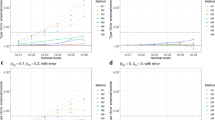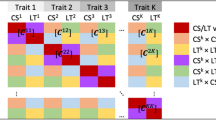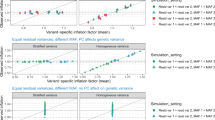Abstract
In a common pharmacogenomic scenario, outcome measures are compared for treated and untreated subjects across genotype-defined subgroups. The key question is whether treatment benefit (or harm) is particularly strong in certain subgroups, and therefore the statistical analysis focuses on the interaction between treatment and genotype. However, genome-wide analysis in such scenarios requires careful statistical thought as, in addition to the usual problems of multiple testing, the marker-defined sample sizes, and therefore power, vary across the individual genotypes being evaluated. The variability in power means that the usual practice of using a common P-value threshold across tests has difficulties. The reason is that the use of a fixed threshold, with variable power, implies that the costs of type I and type II errors vary across tests in a manner that is implicit rather than dictated by the analyst. In this paper we discuss this problem and describe an easily implementable solution based on Bayes factors. We pay particular attention to the specification of priors, which is not a straightforward task. The methods are illustrated using data from a randomized controlled clinical trial in which homocysteine levels are compared in individuals receiving low and high doses of folate supplements and across marker subgroups. The method we describe is implemented in the R computing environment with code available from http://faculty.washington.edu/jonno/cv.html.
This is a preview of subscription content, access via your institution
Access options
Subscribe to this journal
Receive 6 print issues and online access
$259.00 per year
only $43.17 per issue
Buy this article
- Purchase on Springer Link
- Instant access to full article PDF
Prices may be subject to local taxes which are calculated during checkout





Similar content being viewed by others
References
Shen Y, Nicoletti P, Floratos A, Pirmohamed M, Molokhia M, Geppetti P et al. Genome-wide association study of serious blistering skin rash caused by drugs. Pharmacogenomics J 2012; 12: 96–104.
de Keyser CE, Eijgelsheim M, Hofman A, Sijbrands EJG, van der Zee AHM, van Duijin CM et al. Single nucleotide polymorphisms in genes that are associated with a modified response to statin therapy: the Rotterdam Study. Pharmacogenomics J 2012; 11: 72–80.
Bacanu SA, Whittaker JC, Nelson MR . How informative is a negative finding in a small pharma-cogenetic study? Pharmacogenetics J 2012; 12: 93–95.
Barber JM, Mangravite LM, Hyde CL, Smith DICJD, McCarty CA, Li X et al. Genome-wide association of lipid-lowering response to statins in combined study populations. PLoS One 2010; 5: e9763.
Maranville JC, Luca F, Richards AL, Wen X, Witonsky DB, Baxter S et al. Interactions between glucocorticoid treatment and cis-regulatory polymorphisms contribute to cellular response phenotypes. PLoS Genetics 2011; 7: e1002162.
Wen X, Stephens M . Bayesian methods for genetic association analyses with heterogeneous subgroups: from meta-analysis to gene-environment interactions. Annals ofApplied Statistics 2013, Under revision.
Flutre T, Wen X, Pritchard J, Stephens M . A statistical framework for joint eQTL analysis in multiple tissues. PLoS Genetics 2013; 9: e1003486.
Mangravite LM, Engelhardt BE, Medin MW, Smith JD, Brown CD, Chasman DI et al. A statin-dependent QTL for GATM expression is associated with statin-induced myopathy. Nature 2013; 7: e36888 Available online, March 2013.
Wakefield JC . Reporting and interpretation in genome-wide association studies. Int J Epidemiol 2008; 37: 641–653.
Spence JD, Howard VJ, Chambless LE, Malinow MR, Pettigrew LC, Stampfer M et al. Vitamin Intervention for Stroke Prevention (VISP) trial: rationale and design. Neuroepidemiology 2001; 16: 16–25.
Risch N, Merikangas K . The future of genetic studies of complex human diseases. Science 1996; 273: 1516–1517.
Dahlman I, Eaves IA, Kosoy R, Morrison VA, Heward J, Gough SCL et al. Parameters for reliable results in genetic association studies in common disease. Nat Genet 2002; 30: 149–150.
Klein RJ, Zeiss C, Chew EY, Tsai JY, Sackler RS, Haynes C et al. Complement factor H polymorphism in age-related macular degeneration. Science 2005; 308: 385–389.
Stacey SN, Manolescu A, Sulem P, Rafnar T, Gudmundsson J, Gudjonsson SA et al. Common variants on chromosomes 2q35 and 16q12 confer susceptibility to estrogen receptor-positive breast cancer. Nat Genet 2007; 39: 865–869.
Wakefield JA . Bayesian measure of the probability of false discovery in genetic epidemiology studies. Am J Hum Genet 2007; 81: 208–227.
Wellcome Trust Case Control Consortium. Genome-wide association study of 14 000 cases of seven common diseases and 3000 shared controls. Nature 2007; 447: 661–678.
McCarthy MI, Abecasis GR, Cardon LR, Goldstein DB, Little J, Ioannidis JPA et al. Genome-wide association studies for complex traits: consensus, uncertainty and challenges. Nat Rev Genet 2008; 9: 356–369.
Benjamini Y, Hochberg Y . Controlling the false discovery rate: a practical and powerful approach to multiple testing. Journal of the Royal Statistical Society, Series B. 1995; 57: 289–300.
Storey JD . A direct approach to false discovery rates. Journal of the Royal Statistical Society, Series B. 2002; 64: 479–498.
Storey JD, Tibshirani R . Statistical significance for genomewide studies. Proc Natl Acad Sci 2003; 100: 9440–9445.
Marchini J, Howie B, Myers S, McVean G, Donnelly P . A new multipoint method for genome-wide association studies by imputation of genotypes. Nat Genet 2007; 39: 906–913.
Servin B, Stephens M . Imputation-based analysis of association studies: candidate regions and quantative traits. PLoS Genetics 2007; 3: 1296–1308.
Stephens M, Balding DJ . Bayesian statistical methods for genetic association studies. Nat Rev Genet 2009; 10: 681–690.
Pamigiani G, Inoue L . Decision Theory: Principles and Approaches. John Wiley and Sons: Chichester, UK, 2009.
Spiegelhalter DJ, Freedman LS, Parmar MKB . Bayesian approaches to randomized trials (with discussion). Journal of the Royal Statistical Society, Series A. 1994; 157: 357–416.
Wakefield JC . Commentary: Genome-wide significance thresholds via Bayes factors. Int J Epidemiol 2012; 42: 286–291.
Wakefield J . Bayes factors for genome-wide association studies: comparison with P-values. Genet Epidemiol 2009; 33: 79–86.
Li Y, Martin BR, Cravatt BF, Hofmann SL . DHHC5 protein palmitoylates flotillin-2 and is rapidly degraded on induction of neuronal differentiation in cultured cells. J Biol Chem 2012; 287: 523–530.
Berger T, Ueda T, Arpaia E, Chio II, Shirdel EA, Jurisica I et al. Flotillin-2deficiency leads to reduced lung metastases in a mouse breast cancer mode. Oncogene 2012; 32: 4989–4994.
Johansson M, Roberts A, Chen D, Li Y, Delahaye-Sourdeix M, Aswani N et al. Using prior information from the medical literature in GWAS of oral cancer identifies novel susceptibility variant on chromosome 4—the AdAPT method. PLoS One 2012; 7: e36888.
Lumley T, Diehr P, Emerson S, Chen L . The importance of the normality assumption in large public health data sets. Annu Rev Public Health 2002; 23: 151–169.
Acknowledgements
This was research funded by the GARNET grant NHGRI U01 HG005157.
Author information
Authors and Affiliations
Corresponding author
Ethics declarations
Competing interests
The authors declare no conflict of interest.
Additional information
Supplementary Information accompanies the paper on the The Pharmacogenomics Journal website
Supplementary information
Rights and permissions
About this article
Cite this article
Wakefield, J., Skrivankova, V., Hsu, FC. et al. Detecting signals in pharmacogenomic genome-wide association studies. Pharmacogenomics J 14, 309–315 (2014). https://doi.org/10.1038/tpj.2013.44
Received:
Revised:
Accepted:
Published:
Issue Date:
DOI: https://doi.org/10.1038/tpj.2013.44
Keywords
This article is cited by
-
A genome-wide investigation into parent-of-origin effects in autism spectrum disorder identifies previously associated genes including SHANK3
European Journal of Human Genetics (2017)



